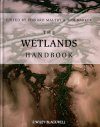About this book
A major reference work providing a comprehensive and functional account of wetlands in the wider global environment. It brings together an international team of experts from the fields of hydrology, ecology, engineering ecosystem restoration, catchments management, wetland and conservation policy, and socio-economics.
It features numerous case studies illustrating how ecosystems work and are best utilized, how to measure wetlands effectiveness and address its failures, and methods for wetlands restoration. It adopts a functional approach with a focus on freshwater wetlands, and is aimed at placing the care and understanding of wetlands more firmly at the heart of environmental management.
It links fundamental scientific and technical knowledge with sound management policy - coverage which will appeal to a growing community of wetland managers, researchers, and policy and regulatory decision-makers.
Contents
PREFACE 1 WETLANDS IN THE GLOBAL ENVIRONMENT 1.1 Introduction - The changing Wetland Paradigm. Maltby E. 1.2 Global Distribution, Diversity, and Human Alterations of Wetland Resources. Whigham D.F. 1.3 Biodiversity in wetlands. Gopal B. 1.4 Peat as an Archive of Atmospheric, Climatic and Environmental Conditions. Wieder R.K., Turetsky M.R. and Vile M.A. 2 WETLANDS IN THE NATURAL ENVIRONMENT: HOW DO WETLANDS WORK?2.1 Introduction - The dynamics of wetlands. Maltby E. 2.2 Hydrological Dynamics I: Surface Waters, Flood and Sediment Dynamics. Baker C., Thompson J.R. and Simpson M. 2.3 Hydrological dynamics II: Groundwater and Hydrological Connectivity. Gilvear and Bradley 2.4 Hydrological dynamics III: Hydro-ecology. Grootjans A.P. and Van Diggelen R. 2.5 Biogeochemical Dynamics I: Nitrogen Cycling in Wetlands. White J.R. and Reddy K.R. 2.6 Biogeochemical Dynamics II: Cycling and storage of phosphorus in wetlands. Richardson C.J. and Vaithiyanathan P. 2.7 Biogeochemical dynamics III: The Critical Role of Carbon in Wetlands. Dise N. 2.8 Wetland Biogeochemical Cycles and their Interactions. Verhoeven J.T.A. 2.9 Ecological Dynamics I: Vegetation as a bioindicator and as dynamic community. Clement B. and Proctor M. 2.10 Ecological Dynamics II: The influences of vertebrate herbivory on ecological dynamics in wetland ecosystems. van den Wyngaert I.J.J. and Bobbink R. 2.11 Ecological Dynamics III: Decomposition in Wetlands. Bridgham S.D. and Lamberti G. A. 3 WETLANDS IN THE HUMAN ENVIRONMENT: HOW CAN WE UTILISE THE WORK OF WETLANDS?3.1 Introduction - Benefiting from the work of wetlands. Maltby E. 3.2 Wetlands and Water Resources. McCartney M.P. and Acreman M.C. 3.3 Characterisation, Development and Management of Wetland Soils. Bonnett S.A.F., Pons L.J. and Maltby E. 3.4 The role of buffer zones for agricultural runoff. Blackwell M.S.A., Hogan D.V., Pinay G. and Maltby E. 3.5 Wetlands for contaminant and waste water treatment. Kadlec R.H. 4 WETLAND ASSESSMENT: HOW CAN WE MEASURE THAT WETLANDS ARE WORKING?4.1 Introduction - Methodologies for Wetland Assessment. Larson J.S. 4.2 The United States HGM (hydrogeomorphic) Approach. Brinson M.M. 4.3 Development of a European methodology for functional assessment of wetlands. Maltby E. 4.4 Wetlands Assessment in Practice: Development and Application In the United States Regulatory Context. Smith R.D. 4.5 Wetland Evaluation in developing countries. Roggeri H. 4.6 Methodologies for Economic Evaluation of Wetlands and Wetland Functioning. Turner R.K., Brouwer R, and Georgiou S. 5 WETLAND DYSFUNCTIONING: WHAT HAPPENS WHEN WETLANDS DO NOT WORK?5.1 Introduction - How Do Wetlands Fail? Ewel K.C. 5.2 Hydrological impacts in and around wetlands - from temperate to tropical floodplains. Acreman M.C. and McCartney M.P. 5.3 Biotic pressures and their effects on wetland functioning. Finlayson C.M. 5.4 Human impacts - farming, fire, forestry and fuel. Joosten H. 6 WETLAND RESTORATION: MAKING WETLANDS WORK AGAIN 6.1 Introduction - Re-establishment of wetland functioning. Maltby E.6.2 Restoration of wetland environments: lessons and successes. Van der valk A. 6.3 Replumbing wetlands - managing water for the restoration of bogs and fens. Money R.P., Wheeler B.D., Baird A.J. and Heathwaite A.L. 6.4 Restoring wetlands for wildlife habitat. Ramseier D., Klotzli F., Bollens U. and Pfadenhauer J. 6.5 Wetland Conditions and Requirements for maintaining Economically Valuable Species: Waterfowl, Furbearers, Fish and Plants. Ross L.C.M. and Murkin H.R. 7 SUSTAINABLE UTILISATION OF WETLANDS: BALANCING ECOSYSTEM FUNCTIONING AND HUMAN NEEDS 7.1 Introduction - Sustainable wetlands in a global context. Barker T. 7.2 Melaleuca wetlands and sustainable development in the Mekong Delta, Vietnam. Safford R. J., Maltby E, Duong Van Ni and Branch N.P. 7.3 Multiple use of wetlands in Eastern Africa. Howard G.W., Wood A.P. and Bakema R.J. 7.4 Deterioration and rehabilitation of the Lower Danube wetland system. Vadineanu A. 7.5 The Pantanal of Mato Grosso: Linking ecological research, actual use, and management for sustainable development. Junk W.J., Da Silva C.J., Wantzen K.M., Nunes de Cunha C. and Noguera F. 7.6 Wetlands for conservation and recreation use in the Norfolk and Suffolk Broads. Barker T., Crooks S. and Schutten J. 7.7 Everglades and agriculture in south Florida. Kadlec R.H. and Maltby E. Conclusions: Wetlands for the Future. Maltby E.INDEX
Customer Reviews
Biography
Edward Maltby is Professor of Wetland Science, Water and Ecosystem Management and Director of the Institute for Sustainable Water, Integrated Management and Ecosystem Research (SWIMMER) at the University of Liverpool, UK. Tom Barker is an ecologist at SWIMMER specialising in catchment relationships with ecosystems, including carbon sequestration and physico-chemical dynamics, particularly in lakes and wetlands.


































